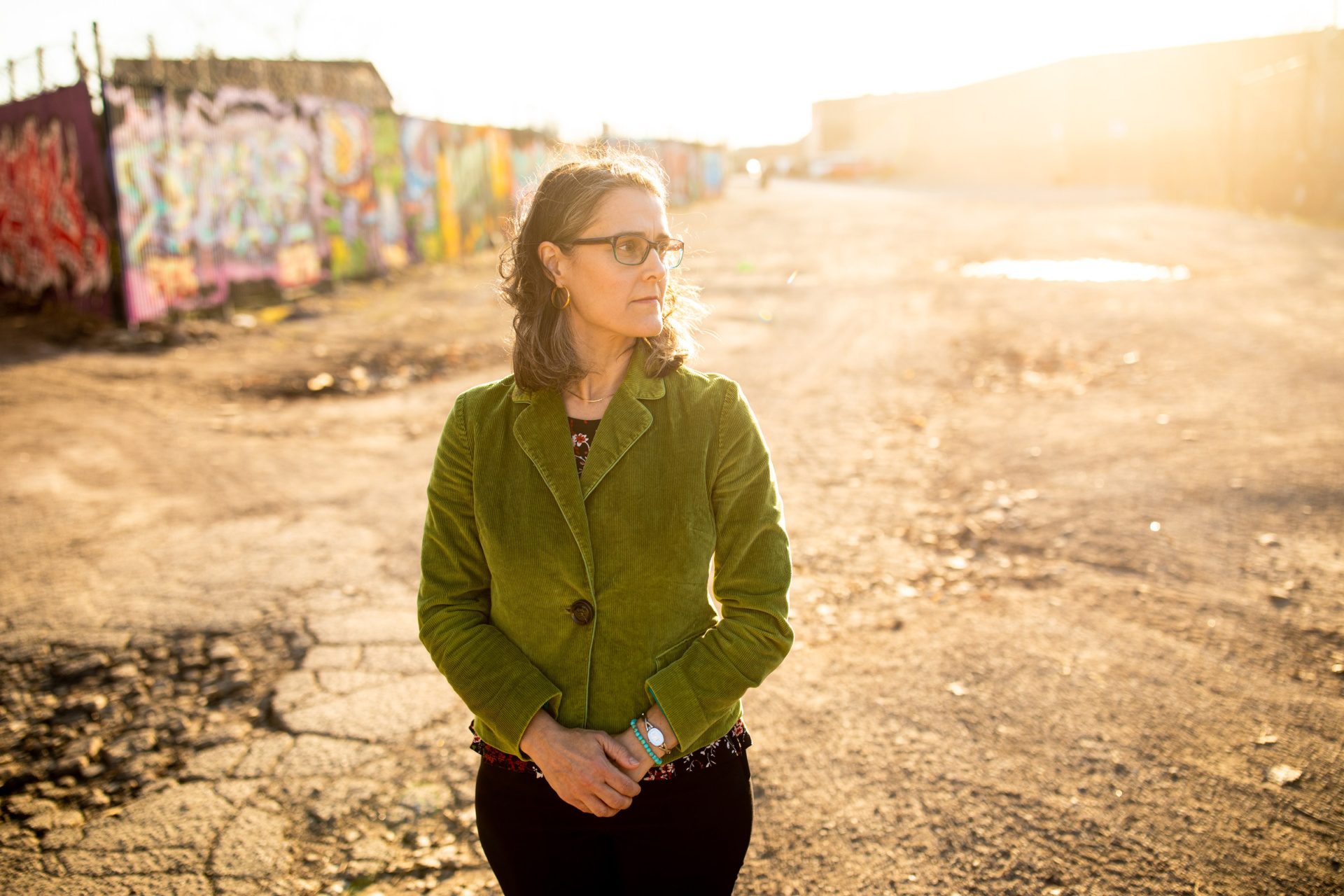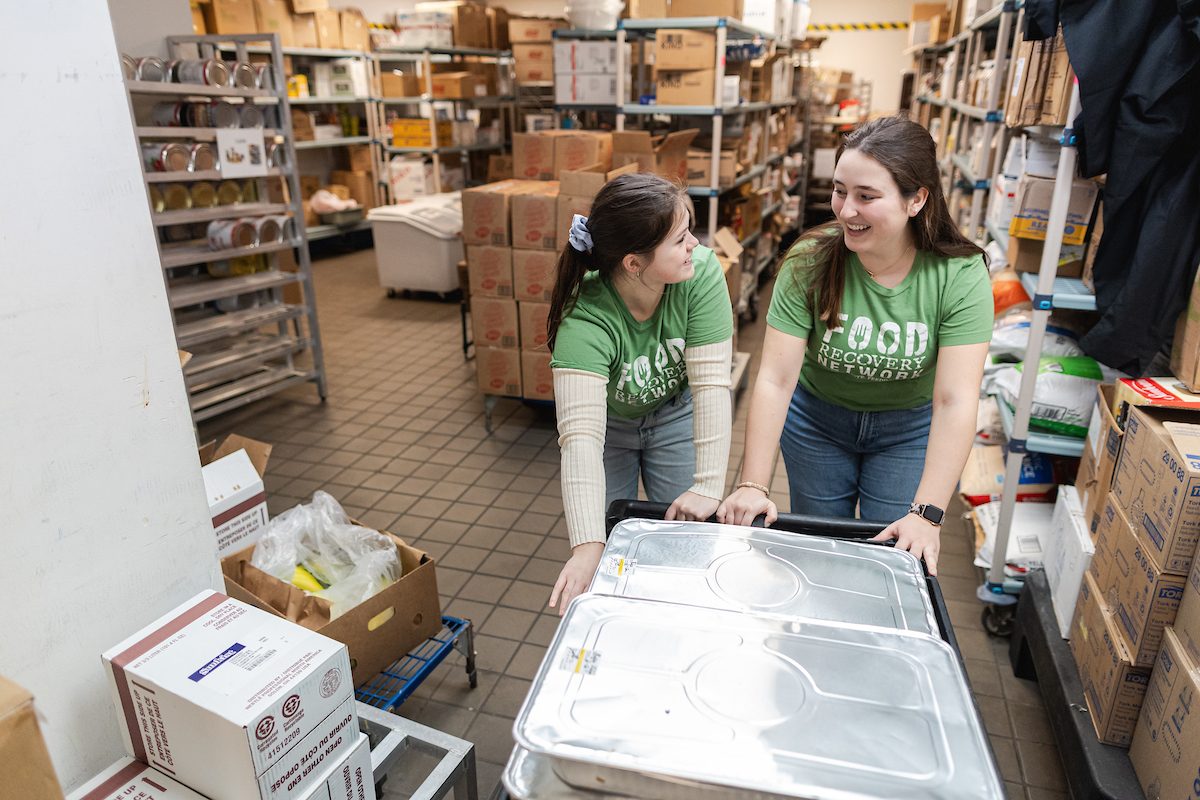The anti-gentrifiers
Not all parks are created equal—Loyola researchers are investigating the tricky balance between urban greening and displacement.

The 606 is only six years old, though it’s difficult to remember Chicago’s Northwest Side without it. Billed as a new urban playground and developed with intensity by former mayor Rahm Emanuel, the trail and park system—2.7 miles east to west, slicing through four neighborhoods—repurposes an elevated industrial train line left abandoned and feral. In its place now sits a sophisticated pedestrian greenway essentially hidden from the street below. There are bikers and rollerbladers and joggers and dog walkers. Couples on coffee dates. Benches for people-watching. Blooming flowers to admire. It’s an environmental improvement project, verdant and well-trafficked, that on the surface seems almost impossible to dislike.
But take a stroll down The 606 and notice the ever-expanding supply of luxury condos lining the trail, their iron balconies hanging overhead. Peek into the shops and restaurants down below, fresh with paint and catering to an unmistakably affluent clientele. And later, when you’ve hung the bike back in the garage, review the research on surging home prices in the neighborhoods served by The 606. Three- and four-flats in Logan Square and Humboldt Park are sold and torn down for stately single-family homes. Rents and property taxes for longtime residents are surging. The character of these once working-class blocks is changing, unmistakably and permanently.
Everyone wants a piece of the park. Who can claim it as their own?

THE COST OF GREEN INVESTMENT
Not long after The 606 opened to the public, Tania Schusler, an assistant professor at Loyola University Chicago’s School of Environmental Sustainability (SES), attended an environmental conference where panelist after panelist extolled the virtues of urban greening. Cleaning up contamination or making “green” investments (tree planting, playgrounds, bike trails) had become an urban planning prerogative over the preceding decade, a means to repurpose disused land and reduce pollution burdens on a city’s most exposed populations. The High Line—which transformed a decrepit railway along Manhattan’s western edge and debuted to global acclaim in 2009—was the country’s most high-profile example. Parks and paths, the theory went, could majorly drive social and economic progress.
Schusler did not doubt that cleaner soil, purer air, and increased access to green space would promote physical and mental health, particularly in low-income neighborhoods. But she couldn’t quite square the unadulterated enthusiasm at the conference with the chatter she was hearing back in Chicago. Many residents seemed freaked out that large-scale beautification initiatives like The 606, noble as they might appear, would inevitably price them out. The success or failure of any given project rarely took into account whether or not that project sustained a community’s existing character. Look no further than New York City, where development exploded alongside the High Line, sending small businesses and middle-class neighbors fleeing for outer boroughs. To some, environmental quality and gentrification looked inextricably linked.
Following the conference, Schusler and Amy Krings, an assistant professor at Loyola’s School of Social Work, took an environmental tour developed by the Little Village Environmental Justice Organization (LVEJO), which for 25 years has successfully fought to make its largely Latinx neighborhood on Chicago’s West Side less toxic. The activists’ shared their underlying anxiety around gentrification, fully underway in nearby Pilsen and creeping towards Little Village, and were curious to learn about urban greening strategies that didn’t catalyze gentrification. What was working elsewhere around the country, and what wasn’t?
UNDERSTANDING THE IMPACT
Published in 2018 with support from Loyola’s Center for the Human Rights of Children, Schusler’s and Krings’ first technical report took a 30,000-foot view, describing the emerging concept of environmental gentrification broadly and summarizing some existing research. “Most of the writing on the topic has been done within the last 10 years,” says Schusler. “The High Line project drew a lot of attention, which led researchers to start asking similar questions in other places.”
They followed that technical report with a scholarly literature review, which was published in 2020, in the International Journal of Social Welfare, investigating more systematically how community groups have managed tensions between “fighting for neighborhood environmental improvements and indirectly attracting wealthier and, often, whiter newcomers.” Both papers affirmed some of LVEJO’s fears. As Schusler and Krings concluded, “although sustainable development aims to address economic, social, and environmental imperatives, in practice, projects branded as sustainable often embody a neoliberal market logic that can reinforce racial and class inequalities.”
Is it necessary for there to be hazards in a community for it to be affordable?
— Amy Krings , assistant professor, School of Social Work
Next, they applied for a grant to conduct their own original study, exploring the question locally to understand more thoroughly how Chicagoans perceive these tensions. Theirs took the form of interviews, 27 in all, with experts from an assortment of fields: environmental justice, public health, affordable housing, urban planning, community and industrial development. The authors deliberately chose diverse subjects who hailed from different zip codes; a person’s experience with green gentrification necessarily differs depending on the history and demographic composition of their neighborhood. The second technical report Schusler and Krings produced, Environmental Gentrification in Chicago: Perceptions, Dilemmas, and Paths Forward, was published this past September.
Colette Copic, an environmental science master’s student in SES, was hired to help coordinate the conversations and code the results. She found the interviews both an interesting diversion from her coursework (sampling crayfish) and illuminating.
A COMMUNITY-CENTERED APPROACH
The second report yielded fascinating insights. Not everyone in Chicago is frightened about green gentrification, for starters. In corners of the city like the Southeast Side, where industrial jobs have long-since fled and livable wages are in short supply, residents are actually eager for the introduction of green technology and manufacturing. Disinvestment, rather than aggressive development, prompts existential stress.
That said, plenty of Chicagoans are indeed anxious about environmental improvements amplifying gentrification. They worry primarily about the spiking cost of living but also the disruption of cultural and social networks; even when not displaced, those anchored in a given neighborhood can start to feel like outsiders in their own backyard. Larger-scale projects that can become focal points for development, meanwhile, are more worrisome than smaller pocket parks or community gardens. And if environmental improvements aren’t coupled with some consideration of future affordability, a project’s entire purpose can be undermined.
So how best to ensure a neighborhood’s environmental well-being without running out the very people who stand to benefit most? On this question, the research in unequivocal—cities should take a more community-centered approach to greening initiatives, deepening relationships among government agencies, technical experts, and community-based organizations so that local leaders have ownership over planning. In a similar vein, some interviewees suggested that redevelopment or revitalization proposals of a certain footprint should include a racial equity impact assessment, similar to how environmental impact statements are legally mandated for major federal projects. And swinging big isn’t always necessary, or even preferable. There’s no need to “romanticize environmental improvements,” Krings warns. A modest and gradual approach to greening can still net comparable health and aesthetic goals. (Some in the field have coined this the “just-green-enough” approach.)
The researchers’ conclusions were recently reinforced by way of El Paseo Trail. If built, the multi-use path would overhaul four miles of abandoned railway from the east side of Pilsen through South Lawndale. Pilsen activists had long considered the shuttered Burlington Northern Santa Fe line an eyesore and a magnet for illicit activities. But neighbors got skittish when the Emanuel administration, in 2016, sped ahead with preliminary engineering and environmental feasibility studies. Pilsen had already seen a drastic population shift since the turn of the century, with the neighborhood’s Latinx population dropping (by 30 percent, according to some estimates) as property values spiked. With an aggressive construction timeline, El Paseo seemed to some a redux of The 606, driven less by community needs than by grand (profit-driven) ambitions.
People know their neighborhood. There are so many voices on the ground that aren’t being tapped into as often as they should be.
— Colette Copic , master's student, School of Environmental Sustainability
Acquisition and remediation proved challenging, though, dampening enthusiasm inside City Hall. And the procedural delays gave community members time to organize. In 2019, voters in Pilsen and Little Village overwhelmingly passed a referendum requiring a community benefits agreement for any El Paseo expansion. Earlier in 2021, Chicago’s City Council also approved two anti-deconversion ordinances, one for Pilsen and one for the immediate areas surrounding The 606, designed to preserve “naturally occurring” affordable housing in two- to eight-unit buildings.
And on a former brownfield site not far from the proposed launch point of El Paseo Trail, Chicagoans of all stripes can still access El Paseo Community Garden, an unmitigated urban greening success story. Run by volunteers and funded through grants, the nonprofit supports gardening, composting, public art, bonfires, and free movie nights. The permaculture “food forest” is a relatively new addition, developed with an eye towards foraging and habitat preservation. The acreage is small but wonderfully dense, with a winding gravel walkway and benches to admire the horticulture and the colorful mural across the way. In 2020, the city approved another half-acre expansion.
Gentrification is encroaching; construction cranes in the distance serve as slender harbingers. But this stretch of once-abused land—safe, welcoming, and flourishing—is Pilsen’s to control. It’s just green enough, and it’s not going anywhere.
